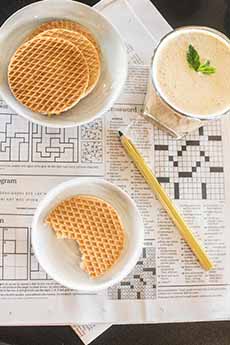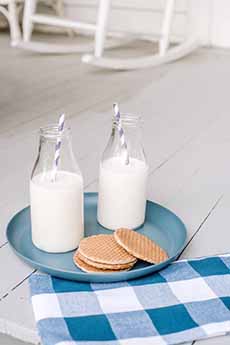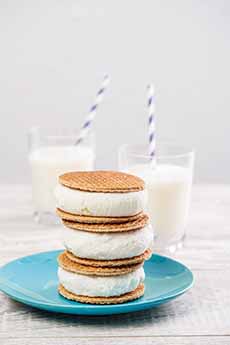Stroopwafel Cookies: Delicious For Every Day & Cookie Gifts
|
|
Some people consider that the holiday season begins pre-Halloween—Hallothanksmas is a word first printed in The Baltimore Sun on Halloween of 1963. While our local Home Depot has had Christmas trees on display since August, to us holiday season begins the day after Halloween. To us, the holiday season is Thanksmas. Each year The Nibble presents food-related holiday gift suggestions. Most of them can double as gifts for Thanksgiving hosts. Or if you are the host and like to give party favors, there are recommendations that can do double duty. Stroopwafels are Dutch waffle sandwich cookies with a caramel filling. They’re so enjoyable, we’ve been wondering why they haven’t become a “thing” in the coffee-loving U.S. They’re much more versatile, sturdy, and affordable than French macarons. Let’s start the trend! Stroopwafels are a centuries-old Dutch sweet from the town of Gouda in South Holland*. They’re the second-most-famous food from Dutch cuisine, after the Gouda cheese. The pronunciation is just as it appears, with a roll of the “r” to sound authentically Dutch. “Stroop” means syrup in Dutch, and the waffle cookies were originally made with crumbs held together with syrup. The traditional way to eat these cookies is with a cup of coffee, tea, or cocoa. Just before it is eaten, the stroopwafel is placed like a lid, on top of the hot cup, in order to warm up the syrup. The filling melts a bit, and scents of caramel perfume the air. A glass of cold milk or iced coffee works just as well, since a good stroopwafel doesn’t need any extra softening to be enjoyed (analogy: warm chocolate chip cookies vs. cooled chocolate chip cookies). Or, there’s the microwave. Stroopwafel cookies were invented in the city of Gouda in 1784. Different sources cite different dates, and the identity of the inventor is lost to history. It’s a reasonable guess that it was a poor housewife trying to scrimp together something to eat, who “glued” crumbs together with syrup. This poor man’s food evolved into waffle cookie sandwiches: two crisp waffle-textured rounds with a caramel or syrup filling. Stroopwafels are ubiquitous in Holland: from street carts to cafés, from mass-market supermarket brands to artisan-baked cookies. In the summer, the caramel doesn’t get drippy: just nicely creamy. Fillings have evolved beyond the original syrup. Different companies flavor the syrup or caramel with cinnamon, chocolate, honey or vanilla. Sometimes, chopped nuts are added to the filling. The cookie is known in the U.K. as a caramel cookie, and by its English translation, syrup waffle. The eponymous three brothers were born and raised in Georgia by a Dutch father and a Georgia mother. Dad wanted his family to experience the joys of stroopwafels, but there were none to be found in stores. Online he found imported Dutch stroopwafels. But after trying them, he realized that they were not made to optimize taste, but to have a long shelf life. The family wanted fresh stroopwafels, and set out to make their own from scratch, with homemade caramel filling. They were so happy with the result that they started to sell the cookies at their community market. Everyone loved them, and now they are available to all of us. The cookies are made with natural ingredients: no artificial preservatives, colors, flavorings, fatty fillers or high fructose corn syrup. Everything is made from scratch, and the cookies are indeed fresh! The “enjoy-by” dates are just 26 weeks from baking. Videos on the website show the cookies being made—all my hand, just as the brothers’ Dutch grandma made them. You can order: There are cookie subscriptions. For wedding favors or Valentine gifts, the heart-shaped cookies are packaged in gold boxes. |
|
|
________________ *The difference between Holland and The Netherlands: The Netherlands, officially the Kingdom of The Netherlands, consists of 12 provinces, of which Holland refers to two: Noord-Holland North Holland) and Zuid-Holland (South Holland). Amsterdam is in North Holland, Rotterdam is in South Holland, as is The Hague (Den Haag). Utrecht, the fourth-largest city, is not in Holland but is located in the province of Utrecht [source]. |
||








